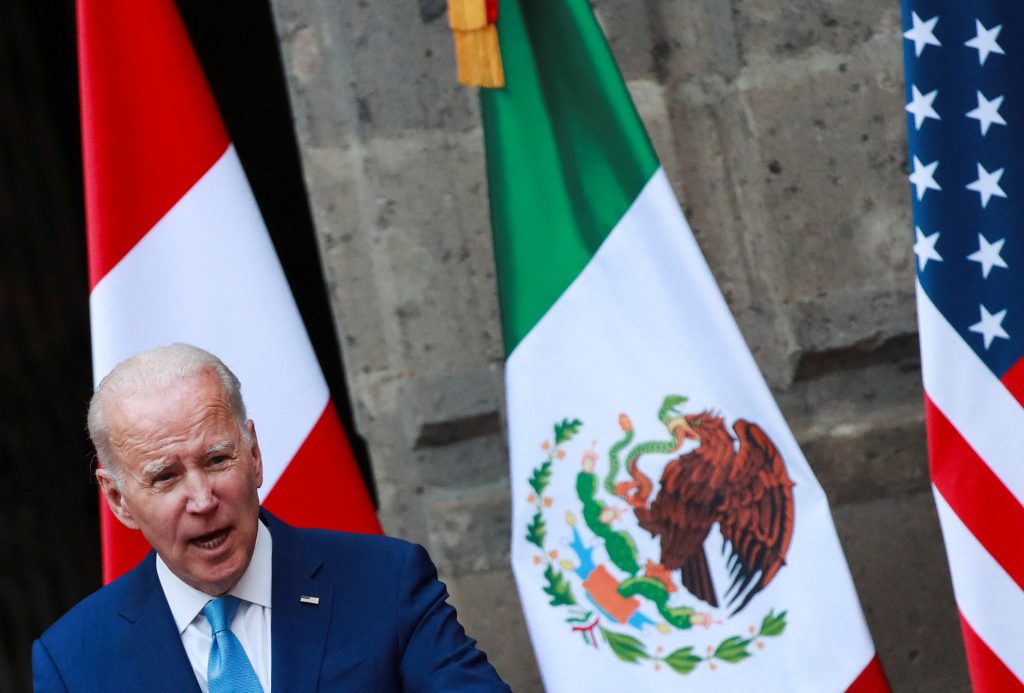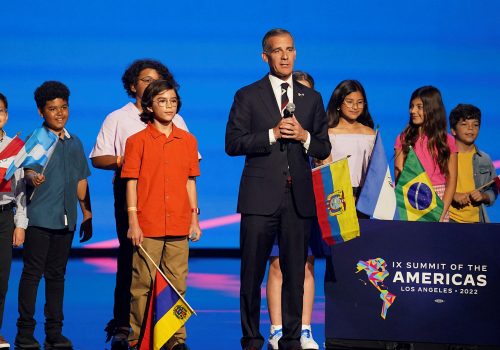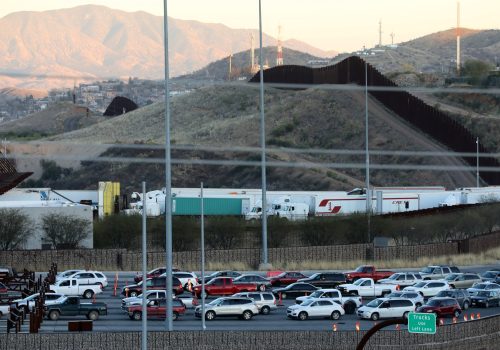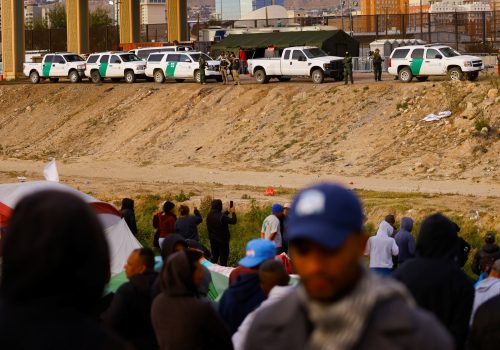Recently, US President Joe Biden toasted a group of governors, praising their ability to “get things done”—without the lengthy delays and debates of national politics. And last month, US Secretary of State Antony Blinken told mayors that their “leadership is vital, and it’s going to be even more so in the years ahead.”
Taken together, their comments signal a broader recognition from the Biden administration of the power of local officials to help achieve national goals. But as Biden works to boost North American economic competitiveness vis à vis China, US governors and mayors are being left out of the conversation. They’re not the only ones: Local leaders across North America, from Mexico to Canada, are being left out of discussions geared toward improving the continent’s economic integration. Biden should tap into the economic and political power of local leaders, and he should start by including them in diplomatic summits such as the North American Leaders Summit (NALS).
Local leaders drive day-to-day collaboration throughout North America, yet they weren’t invited to the NALS last month. So while Biden, Mexican President Andrés Manuel López Obrador (known as AMLO), and Canadian Prime Minister Justin Trudeau met to “promote a common vision for North America,” that vision will be unachievable without the local officials who have built a regional web of economic integration capable of weathering national partisan shifts. Biden, AMLO, and Trudeau should embrace this web by encouraging local and national leaders to establish multi-level ties between their governments and to deepen subnational bonds across borders.
A web of economic integration
The North American countries have a crucial, yet also tense, relationship: That was evident at NALS, which took place amidst Washington and Ottawa’s ongoing disputes with Mexico City’s energy policies. The summit itself reflects this inconsistency in the North American relationship, as last month’s convening was the first in five years and was pushed back several times. The US-Mexico relationship has been complicated by national politics, including when former US President Donald Trump called for a border wall and when AMLO boycotted the US-hosted Summit of the Americas in 2022. The US-Canada relationship also experienced friction during the nineteen-month COVID-19 border closure, the longest border restriction the countries have shared in history.
But US mayors and governors routinely build a foundation of cooperation with their cross-border counterparts focused on practical priorities such as employment and economic growth. Mexico and Canada are the United States’ top trading partners, and the economic interlinkages are most obvious in border states. In 2021, Mexican foreign-owned enterprises in California provided nearly ten thousand jobs, while seven in every ten dollars invested in Baja California, Mexico, come from the United States. The same year, Mexican companies investing in Texas generated 5,364 jobs while Texan companies investing in Mexico created 9,110 jobs. The economic impacts are particularly clear in smaller states such as Vermont, where Canadian-owned businesses employed nearly three thousand people in 2021 and Canadian tourists have contributed two hundred million dollars annually to the state’s economy.
Such collaboration is bipartisan. In April 2021, North Dakota Governor Doug Burgum, a Republican, created the Essential Worker Cross-Border Vaccination Initiative with the Manitoba premier to vaccinate essential workers transporting goods and services across the border, ensuring that commercial flows between their communities remain ongoing. In April 2022, Texas Governor Greg Abbott, a Republican, signed memoranda of understanding with the governors of Mexico’s four border states to enhance border security and mitigate slowdowns in commercial border traffic. And in October 2022, California Governor Gavin Newsom, a Democrat, announced an agreement between Californian and Mexican border communities to support the construction of the Otay Mesa East Port of Entry at the San Diego-Tijuana border, which is being built as part of an effort to boost economic cooperation and trade.
Locally driven economic relationships pave the way for economic integration on a national level. Javier Martínez, founder and president of the Association of Mexican Entrepreneurs Los Angeles, told us that investment between California and Mexico drives the “incorporation of small and medium firms [into] the supply chains of the global firms,” strengthening national economic collaboration and opening opportunities for practices such as nearshoring. Local leaders are much more than implementers of national economic policies—they’re incentivized by the potential economic benefits to shape trade relationships from the bottom up. This was evident in 2017 and again in 2019, when Mexican and US mayors came together to support a modernized North America Free Trade Agreement and later urge the passage of the US-Mexico-Canada Agreement (USMCA). In 2022, US and Canadian mayors prepared a joint letter calling on their national governments to repeal the remaining COVID-19 border restrictions and hasten the return to pre-pandemic cross-border exchanges.
The collaboration spearheaded by local leaders is resilient to national partisan shifts. The aforementioned diplomatic disputes between the United States, Mexico, and Canada can impede cooperation and stall advancements in the North American relationship—yet these national-level tensions typically don’t stop cities and towns from promoting trade and tourism with their northern and southern neighbors. Initiatives by Biden, AMLO, and Trudeau to strengthen North American competitiveness may not outlast the national leaders’ terms if they don’t actively engage with the local leaders who have built the region’s economic integration and have a vested interest in its future.
A missed opportunity at NALS
At NALS, national leaders laid out their plans to mount a combined defense against China’s rising economic dominance by overhauling North American industrial capacity and integration. The gathered leaders announced steps to boost their roles in critical-mineral supply chains, which are currently dominated by China. They also pledged to organize the “first-ever trilateral semiconductor forum” as the next move in an escalating contest with China over control of the industry.
These policies aim to reverse a decline in US-based manufacturing that has led to a $382.9 billion US goods trade deficit with China and the US manufacturing workforce declining by more than a third. Because these local leaders have their communities in mind, they’re accustomed to reframing national-security objectives (such as semiconductor manufacturing) as priorities for their districts and constituents. Yet the roster for the trilateral semiconductor forum scheduled for early 2023 only includes “senior industry representatives” and “cabinet level participation” from the three countries. There is no mention of a role for mayors and governors who will play an essential role in forging the requisite economic and diplomatic cooperation from the bottom up.
How to implement this cooperation
North American national leaders should affirm local leaders’ role as trailblazers in their mission of advancing a closer economic alliance. They can do that by making space for local officials at the next NALS, whenever it takes place. The White House should work with US State Department’s Special Representative for Subnational Diplomacy Nina Hachigian to design parallel sessions at NALS that convene local leaders who represent communities that are part of critical-mineral and semiconductor supply chains to compare strategies and report out to national leaders. These sessions should focus on creating city- and state-specific NALS deliverables on economic cooperation and trade that resonate with communities in all three countries.
In contrast to the most recent NALS, mayors from across the Western Hemisphere will convene at this year’s inaugural Cities Summit of the Americas; it’s equally important to bring national leaders to spaces in which local leaders are gathering to ensure that neither perspective is siloed. The US State Department, White House, 24 Sussex, and the Palacio Nacional should ensure that cabinet-level officials and above are also represented at the Cities Summit so that they can get up to speed on their local leaders’ priorities and ideas.
In between the various summits, national leaders should support and expand bilateral initiatives led by cities and states. Many border communities have taken it upon themselves to set up economic commissions: For example, the Los Angeles Mayor’s Office, Mexico’s Foreign Ministry, and the Mexican Council of International Affairs launched the MEXLA commission to deepen ties including trade and energy collaboration. The Arizona-Mexico Commission created an economic development committee to strengthen development efforts, and the Texas Association of Business launched a Mexico Trade and Investment Policy Council to help companies navigate the Texas-Mexico business relationship. On the northern border, Michigan’s Economic Development Corporation established an international trade program that leads business delegations to Canada. Meanwhile, the Buffalo Niagara Partnership signed an agreement with two Ontario Chambers of Commerce to help local businesses take advantage of the cross-border economy and trade. Yet the landscape of bilateral cooperation across North America is made up of these sporadic examples that lack consistency and coordination. Hachigian should take stock of existing subnational initiatives to glean effective strategies and assess where more support is needed.
To strengthen existing initiatives led by local leaders, Hachigian’s Unit for Subnational Diplomacy should assemble the knowledge of local leaders who have been fostering bilateral economic partnerships into a toolkit for all US states to use in building cross-border partnerships. Hachigian’s office can then work to disseminate these toolkits and trainings through existing subnational bodies, such as the National Governors Association and US Conference of Mayors.
The Unit for Subnational Diplomacy should also work with universities, research institutions, and local chambers of commerce to conduct a widespread review of state and city-level economic cooperation with Mexico and Canada to identify the benefits of advancing economic cooperation. This uncovered data can be shared with constituents to substantiate the value of maintaining international commissions, incentivize additional mayors and governors to deepen North American trade relationships, and plainly reveal the impact of local efforts to national leaders.
These steps will equip mayors and governors from all fifty states with the tools to champion economic integration initiatives, further strengthening their role as important advisors to national leaders and crucial players in future policy discussions.
North American local leaders are already getting the job done on the ground; they have earned a seat at the diplomatic table.
Willow Fortunoff is an assistant director at the Atlantic Council’s Adrienne Arsht Latin America Center.
Mary Ann Walker is a member of the Atlantic Council’s Adrienne Arsht Latin America Center Advisory Council.
Further reading
Wed, Jul 6, 2022
Mayors are quickly becoming international diplomats. The US can help them thrive.
New Atlanticist By
Mayors will have the opportunity to revitalize US foreign policy at next year's Cities Summit of the Americas—but they'll need national support to shore up their teams and capacity.
Fri, Feb 17, 2023
The transformative power of reduced wait times at the US-Mexico border: Economic benefits for border states
Report By
Atlantic Council's new data shows that a mere 10-minute reduction in wait times – without any additional action – can create thousands of Mexican jobs, grow the gross domestic product (GDP) of several Mexican states, and generate hundreds of thousands of dollars in new spending in the United States.
Thu, Jan 5, 2023
Biden just tightened US migration policy. Can he calm the surge at the border?
New Atlanticist By
We asked our experts what’s behind the policy shifts from the White House and what happens next.
Image: US President Joe Biden attends a joint news conference with Mexican President Andres Manuel Lopez Obrador and Canadian Prime Minister Justin Trudeau, at the conclusion of the North American Leaders' Summit in Mexico City, Mexico, January 10, 2023. Photo via REUTERS/Henry Romero.



